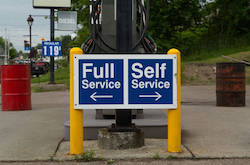Many organizations are learning firsthand that contact centers can play a central role in encouraging and supporting low-cost access channels. For example, the contact center can provide a wealth of information on which contacts can be automated (or handled in 
Here are some things you can do to further the contact center’s opportunity to build self-service channels:
- Equip agents to educate customers on self-service options. Agents should be trained on the advantages and use of these alternatives so that they can encourage customers to use these options when appropriate.
- Collect and analyze data about contacts currently handled in the center. Look for opportunities to provide self-service features or build communities that customers will want to use. Improved speed of access and around-the-clock availability are often at the top of the list.
- Observe agents handling contacts, step-by-step. Your best agents really know how to serve customers; watching them work can present many opportunities for developing and improving self-service systems. In many ways, self-service systems can be modeled after effective agent practices.
- Involve agents in system design. Your agents should actively serve on project teams responsible for building self-service systems. They can also help monitor and test systems and interpret customer behavior and feedback.
- Integrate self-service and contact center systems and developments. Integrated systems can enable agents to use the information captured in self-service applications when assisting customers.
- Capture customer feedback about self-service systems. The nature of input is that you’ll get a lot more of it when things go wrong than when they go right. Even so, customers who share their dissatisfaction represent the tip of the iceberg; in most cases, there will be many more who were dissatisfied but who did not bother to tell you. This information is essential to improving system design.
- Enable customers to easily reach agents. If callers can’t reach an agent when necessary, they will often resent the need to use self-service systems. Support may take many forms, such as:
- A clearly identified way to exit an IVR application
- Prominently displayed telephone numbers on your website
- Text-chat, click-to-talk or co-browsing capabilities
- Email addresses and Web templates for questions, comments and other input
- Posting access numbers and alternatives in relevant social communities
- Track data from all support modes and analyze it for improvement opportunities; specifically, why do customer contacts happen? Which do you want to encourage and which do you want to prevent (as possible)?
Self-service systems must be an integrated part of your customer access strategy. If they are perceived primarily as replacements for agents rather than complementary access channels that free agents to do more high- value work, then employees will be less enthusiastic about helping to improve them and encourage their use. But by keeping the focus on cultivating better ways to serve customers, self-service systems become an essential part of building valuable, cost-effective services.
Excerpt from Call Center Management on Fast Forward by Brad Cleveland.


0 Comments